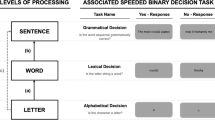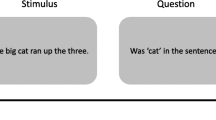Abstract
The present study focuses on the interplay between the linguistic principles and the psycholinguistic processes involved in reading. Results from 56 participants on a letter detection task reveal that readers do not process all function words in the same manner. Omission rates were highest for function words occupying the head of maximal projections such as complementizers and determiners. Prepositions were shown to occupy an intermediary position between content and function words, with omission rates varying depending on their semantic load. Together these results appear to bolster and offer a finer grained picture of the role of function words within the framework of both the Guidance Organization (Greenberg et al. in Psychon Bull Rev 11(3):428–433, 2004) and Attentional Disengagement (Roy-Charland et al. in Percept Psychophys 69(3):324–337, 2007) reading models. The results of the present study are discussed using an X-bar theory approach with the goal of refining the structural account of letter detection errors.
Similar content being viewed by others
References
Abney, S. P. (1987). The English noun phrase in its sentential aspect. Unpublished PhD, Massachusetts Institute of Technology.
Assink E. M. H., Knuijt P. P. N. A. (2000) Reading development and attention to letters in words. Contemporary Educational Psychology 25(4): 347–362
Borillo A. (2002) Il y a prépositions et prépositions. Travaux de linguistique 42: 157–170
Brysbaert M., Drieghe D., Vitu F. (2005) Word skipping: Implications for theories of eye movement control in reading. In: Underwood G. (eds) Cognitive processes in eye guidance. Oxford University Press, Oxford, pp 53–77
Carpenter P. A., Just M. A., Rayner K. (1983) What your eyes do while your mind is reading. In: Rayner K. (eds) Eye movements in reading: Perceptual and language processes. Academic Press, New York, pp 275–307
Chomsky N. (1969) Structures syntaxiques. Seuil, Paris
Chomsky N. (1995) The minimalist program. MIT Press, Cambridge, MA
Coen M., d’Hulst Y. (2003) The syntax and semantics of noun phrases: Theoretical background. In: Coen M., d’Hulst Y. (eds) From NP to DP the syntax and semantics of noun phrases. John Benjamins, Amsterdam
Cohen J. (1968) Multiple regression as a general data-analytic system. Psychological Bulletin 70(6): 426–443
Cohen J., Cohen P., West S. G., Aiken L. S. (1983) Applied multiple regression/correlation analysis for the behavioral sciences. Erlbaum, Hillsdale, NJ
Corcoran D. W. (1966) An acoustic factor in letter cancellation. Nature 210: 658
Drewnowski A. (1981) Missing -ing in reading: Developmental changes in reading units. Journal of Experimental Child Psychology 31(1): 154–168
Drewnowski A., Healy A. F. (1980) Missing -ing in reading: Letter detection errors on word endings. Journal of Verbal Learning and Verbal Behavior 19(3): 247–262
Drewnowski A., Healy A. F. (1982) Phonetic factors in letter detection: A reevaluation. Memory & Cognition 10: 145–154
Foucambert D., Baillé J. (2011) Evolution of the missing-letter effect among student readers between ages 5 and 8. Applied Psycholinguistics 32(1): 1–17
Gaatone D. (2002) Les prépositions: une classe aux contours flous. Travaux de linguistique 42: 23–31
Garner W. R., Clement D. E. (1963) Goodness of pattern uncertainty. Journal of Verbal Learning and Verbal Behavior 2: 446–452
Greenberg S., Healy A. F., Koriat A., Kreiner H. (2004) The GO model: A reconsideration of the role of structural units in guiding and organizing text on line. Psychonomic Bulletin and Review 11(3): 428–433
Greenberg S. N., Koriat A., Shapiro A. (1992) The effects of syntactic structure on letter detection in adjacent function words. Memory & Cognition 20(6): 663–670
Hadley J. A., Healy A. F. (1991) When are reading units larger than letter? Refinement of unitization reading model. Journal of Experimental Psychology: Learning, Memory and Cognition 17: 1062–1073
Healy A. F. (1976) Detection errors on the word the: Evidence for reading units larger than letters. Journal of Experimental Psychology: Human Perception and Performance 2: 235–242
Healy A. F. (1994) Letter detection: A window to unitization and other cognitive processes in reading texts. Psychonomic Bulletin and Review 1: 333–344
Healy A. F., Drewnowski A. (1983) Investigating the boundaries of reading units: Letter detection in mispelled words. Journal of Experimental Psychology: Human Perception and Performance 9: 413–426
Inhoff A. W., Radach R., Eiter B. M., Skelly M. (2003) Exterior letters are not privileged in the early stage of visual word recognition during reading: Comment on Jordan, Thomas, Patching and Scott-Brown (2003). Journal of Experimental Psychology: Learning, Memory and Cognition 29(5): 894–899
Kennedy A. (2000) Parafoveal processing in word recognition. The Quaterly Journal of Experimental Psychology 53(2): 429–455
Kimball J. (1973) Seven principles of surface structure parsing in natural language. Cognition 2(1): 15–47
Knittel M.-L. (2002) Existe-t-il un DP en turc?. Recherches linguistiques de Vincennes 31: 79–96
Koriat A., Greenberg S. N. (1991) Syntactic control of letter detection: Evidence from English and Hebrew nonwords. Journal of Experimental Psychology: Learning, Memory and Cognition 17: 1035–1050
Koriat A., Greenberg S. N. (1993) Prominence of leading functors in function morpheme sequences as evidenced by letter detection. Journal of Experimental Psychology: Learning, Memory and Cognition 19: 34–59
Koriat A., Greenberg S. N. (1994) The extraction of phrase structure during reading: Evidence from letter detection errors. Psychonomic Bulletin and Review 1(3): 345–356
Koriat A., Greenberg S. N. (1996) The enhancement effect in letter detection: Further evidence for the structural model of reading. Journal of Experimental Psychology: Learning, Memory and Cognition 22(5): 1184–1195
Koriat A., Greenberg S. N., Goldshmid Y. (1991) The missing-letter effect in Hebrew: Word frequency or word function?. Journal of Experimental Psychology: Learning, Memory and Cognition 17: 66–80
Leeman D. (2008) Prépositions du français: état des lieux. Langue Française 157(1): 5–19
McConkie G. W., Kerr P. W., Dyre B. P. (1994) What are ‘normal’ eye movements during reading: Toward a mathematical description. In: Ygge J., Iennerstrand G. (eds) Eye movements in reading. Elsevier, Oxford, pp 315–327
McConkie G. W., Kerr P. W., Reddixx M. D., Zola D. (1988) Eye movement control during reading: I. The location of initial eye fixations in words. Vision Research 28: 1107–1118
Mohan P. J. (1978) Acoustic factors in letter cancellation: Developmental considerations. Developmental Psychology 14: 117–118
Moravcsik J. E., Healy A. F. (1995) The effect on meaning on letter detection. Journal of Experimental Psychology: Learning, Memory and Cognition 21: 82–95
Musseler J., Koriat A., Nißlein N. (2000) Letter-detection patterns in German: A window to the early extraction of sentential structure during reading. Memory & Cognition 28(6): 993–1003
Nazir T. A., Jacobs A. M., O’Regan J. K. (1998) Letter legibility and visual word recognition. Memory & Cognition 26(4): 810–821
New B., Pallier C., Fernand L., Matos R. (2001) Une base de données lexicales du français contemporain sur internet: LEXIQUE. L’Année Psychologique 101: 447–462
O’Regan J. K. (1979) Moment to moment control of eye saccades as a function of textual parameters in reading. In: Kolers P. A., Wrolstad M. E., Bouma H. (eds) Processing of visible language. Plenum Press, New York
O’Regan J. K., Jacobs A. M. (1992) Optimal viewing position effect in word recognition: A challenge to current theory. Journal of Experimental Psychology: Human Perception & Performance 18: 185–197
Pollock J. Y. (1997) Langage et Cognition. PUF, Paris
Pelli D. G., Burns C. W., Farell B., Moore-Page D. C. (2006) Feature detection and letter identification. Vision Research 46: 4646–4674
Radach R., Kennedy A. (2004) Theoretical perspectives on eye movements in reading: Past controversies, current deficits and an agenda for future research. European Journal of Cognitive Psychology 16: 3–26
Rayner K. (1998) Eye movement in reading and information processing: 20 years of research. Psychological Bulletin 124(3): 372–422
Rayner K., Pollatsek A., Coltheart M. (1987) Eye movements in reading: A tutorial review attention and performance XII. In: Rayner K., Pollatsek A. (eds) The psychology of reading. Erlbaum, Hillsdale, NJ, pp 327–362
Read J. D. (1983) Detection of Fs in a single statement: The role of phonetic recoding. Memory & Cognition 11(4): 390–399
Roy-Charland A., Saint-Aubin J., Klein R. M., Lawrence M. (2007) Eye movements as direct tests of the GO model for the missing-letter effect. Perception and Psychophysics 69(3): 324–337
Roy-Charland A., Saint-Aubin J., Lawrence M., Klein R. M. (2009) Solving the chicken and egg problem of letter detection and fixation duration in reading. Attention, Perception & Psychophysics 71(7): 1553–1562
Saint-Aubin J., Klein R. M. (2001) Influence of parafoveal processing on the missing-letter effect. Journal of Experimental Psychology: Human Perception and Performance 27(2): 318–334
Saint-Aubin J., Klein R. M. (2008) The influence of reading skills on the missing-letter effect among elementary school students. Reading Research Quarterly 43(2): 132–146
Saint-Aubin J., Klein R. M., Roy-Charland A. (2003) Direct assessments of the processing time hypothesis for the missing-letter effect. Journal of Experimental Psychology: Human Perception & Performance 29: 1191–1210
Saint-Aubin J., Poirier M. (1997) The influence in word function in the missing-letter effect: Further evidence from French. Memory & Cognition 25: 666–676
Schneider V. I., Healy A. F. (1993) Detecting phonemes and letters in text: Interactions between different types and levels of processes. Memory & Cognition 21: 739–751
Schneider V. I., Healy A. F., Gesi A. T. (1991) The role of phonetic processes in letter detection: A reevaluation. Journal of Memory & Language 30: 294–318
Siloni T. (1990) On the parallelism between CP and DP: The case of Hebrew semirelatives. Proceedings of LCJL 1: 135–153
Smith P. T., Groat A. (1979) Spelling patterns, letter cancellation and the processing of text. In: Kolers P. A., Wrolstad M. E., Bouma M. E. (eds) Processing of visible language. Plenum Press, New York
Szabolcsi A. (1994) The noun phrase. In: Kiefer F., Kiss K. (eds) The syntactic structure of Hungarian. Syntax and semantics 27: The syntactic structure of Hungarian. Academic Press, New York, pp 179–275
Vaguer C. (2008) Classement syntaxique des prépositions simples du français. Langue Française 157(1): 20–36
Vitu F. (1991) The influence of parafoveal processing in linguistic context on the optimal landing position effect. Perception and Psychophysics 50: 58–75
Vitu F., O’Regan J. K., Inhoff A. W., Topolski R. (1995) Mindless reading: Eye-movement characteristics are similar in scanning letter strings and reading texts. Perception and Psychophysics 57(3): 352–364
White S. J., Rayner K., Liversedge S. P. (2005) The influence of parafoveal word length and contextual constraint on fixation durations and word skipping in reading. Psychonomic Bulletin and Review 12(3): 466–471
Winer B. J., Brown D. R., Michels K. M. (1991) Statistical principles in experimental design. McGraw-Hill, New York
Author information
Authors and Affiliations
Corresponding author
Rights and permissions
About this article
Cite this article
Foucambert, D., Zuniga, M. Effects of Grammatical Categories on Letter Detection in Continuous Text. J Psycholinguist Res 41, 33–49 (2012). https://doi.org/10.1007/s10936-011-9175-1
Published:
Issue Date:
DOI: https://doi.org/10.1007/s10936-011-9175-1




